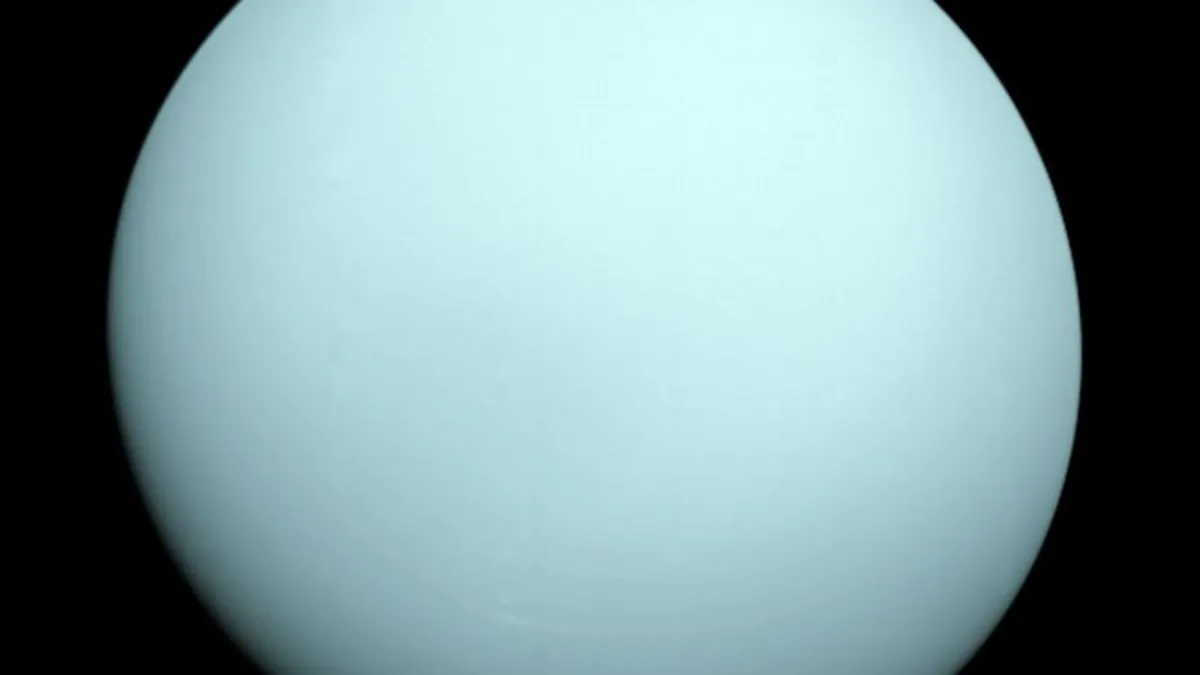
Astronomers have made a groundbreaking discovery with the help of the James Webb Space Telescope (JWST), identifying a previously unknown moon orbiting the ice giant Uranus. This significant finding increases the total number of known moons around Uranus to 29, with the potential for even more undiscovered satellites awaiting detection. The moon was revealed through a series of long-exposure images, each lasting 40 minutes, captured by Webb’s Near-Infrared Camera on February 2, 2025.
Maryame El Moutamid, a lead scientist at the Southwest Research Institute in Boulder, Colorado, expressed excitement over the discovery, stating, “It’s a small moon but a significant discovery, which is something that even NASA’s Voyager 2 spacecraft didn’t see during its flyby nearly 40 years ago.” El Moutamid is the principal investigator of a JWST program focused on analyzing the structure and dynamics of Uranus' often-hidden rings and inner moons.
Due to its small size—measuring approximately 6 miles (10 kilometers) in diameter—and the glow of Uranus' rings, this newly discovered moon remained undetected by Voyager 2, which is the only mission to have ever conducted flybys of Uranus and its neighboring planet, Neptune. El Moutamid noted that it is possible the moon shares a common origin with some of the material that forms Uranus' rings, indicating that both might be remnants of an ancient event.
The newly identified moon, temporarily designated as S/2025 U1, holds the potential to provide insights into how Uranus’ rings are shaped—whether by gravitational influences or historical events. El Moutamid remarked, “The discovery raises questions about how many more small moons remain hidden around Uranus and how they interact with its rings.” This revelation opens the door to further exploration and understanding of Uranus’ complex system.
Finding this tiny moon was no simple task. Its small size and rapid movement rendered it nearly invisible against the bright background of Uranus’ rings. El Moutamid explained that the high resolution and sensitivity of Webb’s Near-Infrared Camera were crucial in identifying such faint celestial objects. The telescope’s ability to capture infrared light has allowed astronomers to gain new insights into Uranus’ rings, moons, atmosphere, and weather patterns during earlier observations.
All of Uranus’ moons are named after characters from the literary works of William Shakespeare and Alexander Pope. The newly discovered moon has yet to receive an official name, which will be determined by the International Astronomical Union, the body responsible for naming celestial objects.
Determining the exact number of moons orbiting Uranus remains a challenge due to the proximity of these natural satellites to the planet and the bright glare emanating from it. Scott Sheppard, an astronomer at the Carnegie Institution for Science, commented on the excitement surrounding the discovery, highlighting the moon's close relationship with Uranus’ inner ring system. “This new Uranus moon is a very exciting find since it is so close to Uranus and likely associated with the inner ring system,” he stated.
Uranus boasts the most extensive collection of small inner moons compared to any other planet in our solar system. Researchers are still puzzled as to how these diminutive moons have avoided collision despite their close proximity. According to NASA, these satellites may play a role in shepherding Uranus’ narrow rings.
Before the Voyager 2 mission provided groundbreaking views of Uranus in 1986, only five moons—the largest—had been identified. Voyager 2 discovered an additional ten moons during its flyby. Since then, telescopes like Hubble and various ground-based observatories have identified a further 13 tiny moons, each measuring between 8 and 10 miles (12 to 16 kilometers) across.
As astronomers look forward, the discovery of S/2025 U1 highlights how modern astronomy is expanding upon the foundational work done by missions like Voyager 2. El Moutamid stated, “Now, nearly four decades later, the James Webb Space Telescope is pushing that frontier even farther.” Future missions planned for the early 2030s, which include an orbiter and an atmospheric probe, promise to deepen our understanding of this enigmatic ice giant.
Uranus has largely been characterized by the data collected during Voyager 2's flyby, but a more detailed exploration is overdue. A dedicated mission could illuminate the planet's atmospheric dynamics, complex magnetic field, and the factors contributing to its extreme axial tilt and ring system. Observations from future missions may also reveal whether any of Uranus' moons are ice-covered ocean worlds.
The planetary decadal survey, published by the National Academies of Sciences, Engineering, and Medicine in 2022, recommended a dedicated Uranus Orbiter and Probe as the next major NASA mission. However, uncertainties remain regarding the mission's place in NASA’s future plans, particularly amidst budgetary challenges. Sheppard noted that even smaller, yet-to-be-discovered moons around Uranus could be much fainter and more difficult to detect, emphasizing the potential for further discoveries.
Maryame El Moutamid and her team aim to gather more details about the newly discovered moon's orbit, search for additional moons, and support the planning of the Uranus Orbiter and Probe mission. “Discovering a new moon around Uranus helps scientists better understand how its strange system formed, sheds light on its rings, and prepares us for future missions like NASA’s Uranus Orbiter and Probe,” she concluded.